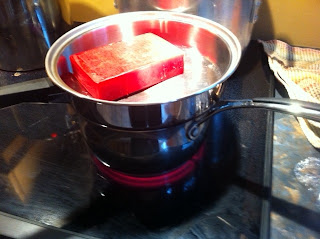
Old cheddar is a favorite among my guests. Try this one for yourself. It takes 9-12 months to age (or even up to 8 years, if you are patient enough!).
...well worth the wait!
History
The cheese originates from the village of Cheddar in Somerset, South West England. Cheddar Gorge on the edge of the village contains a number of caves, which provided the ideal humidity and constant temperature for maturing the cheese. Cheddar cheese traditionally had to be made within 30 miles (48 km) of Wells Cathedral.
Cheddar has been produced since at least the 12th century. A pipe roll of King Henry II from 1170 records the purchase of 10,420 lb (4,730 kg) at a farthing per pound (UK£2.30 per ton). Charles I (1600–1649) also bought cheese from the village. Romans may have brought the recipe to Britain from the Cantal region of France.
Central to the modernisation and standardisation of Cheddar cheese was the nineteenth century Somerset dairyman Joseph Harding. For his technical developments, promotion of dairy hygiene and unremunerated propagation of modern cheese-making techniques he has been described as the father of Cheddar cheese.[ Harding introduced new equipment into the process of cheese making, including his "revolving breaker" for curd cutting, saving much manual effort. The "Joseph Harding method" was the first modern system for Cheddar production based upon scientific principles. Harding stated that Cheddar cheese is "not made in the field, nor in the byre, nor even in the cow, it is made in the dairy." He and his wife were behind the introduction of the cheese into Scotland and North America. Joseph Harding's son, Henry Harding, was responsible for introducing Cheddar cheese production to Australia.
During the Second World War, and for nearly a decade after the war, most milk in Britain was used for the making of one single kind of cheese nicknamed "Government Cheddar" as part of war economies and rationing. This nearly resulted in wiping out all other cheese production in the country. Before the First World War there were more than 3,500 cheese producers in Britain, while fewer than 100 remained after the Second World War.
How to make cheddar
This recipe is made from 5 gallons of milk and makes a 5 lb cheese. Feel free to adjust the ingredients for a smaller batch.
What you'll need:

- 3 gallons 2%, 3 gallons whole (> 3.25%) milk
- 2 1/2 packets (3.4 tsp) mesophilic starter
- 1 1/4 tsp calcium chloride (is using store bought milk)
- 5/8 tsp lipase
- 1 1/4 tablet or 1 1/4 tsp rennet
So... here we go:
1) sterilize all equipment
2) heat milk to 88°F

3) turn off heat
4) Add mesophilic

5) mix well, cover pot and let sit for 45 minutes.
6) Add calcium chloride.

7) Add lipase. Stir well for 1 minute.

8) Make sure milk is still 86°F
9) Add diluted rennet (mix in a small bowl with 1/4 cup lukewarm water before adding to pot). Stir well for 1 minute in a top/down fashion. Top stir for 1 minute.
10) Let sit with cover on for 45 minutes.
11) Check for clean break.
12) Cut into 1/4 inch cubes with whisk
13) Allow curds to set for 5 minutes.
14) Heat curds to 100°F over 30 minutes (2° / 5 mins). Stir gently on occasion.
15) Maintain at 100° for 30 minutes. Sire regularly with whisk.
16) Allow curd to set for 20 minutes.
17) Pour curds and whey into colander with cheese cloth. Let drain for 15 minutes.
18) remove mass from the colander and place on a cutting board.
19) Cut the curd into 3 inch slices.

20) Put the curds in a pot into 100°F water and cover the pot. (I just place the entire pot into the sink and add warm water around the pot until it reaches 100°F)

21) Maintain the curd at 100°F, turning every 15 minutes for 2 hours.
22) Break the curds by hand into 1/4 inch cubes and put them in a covered pot.
23) Put the pot back into the sink full of water at 100°F
24) Maintain temperature, and stir curds every 10 minutes. Do not squeeze the curd, merely keep them from matting.
25) Remove pot from sink.
26) Add 6 tablespoons cheese salt (non-iodized)
27) Place in mold with cheese cloth. Press at 40 lbs for 12 hours. I simply use a weight that is thoroughly soaked, washed, and sanitized with bleach and water.

28) Flip, press at 40 lbs for 12 hours.
29) Flip, press at 40 lbs for 12 hours.
30) Air dry at room temperature until cheese is dry to the touch (2-5) days. Flip regularly.

After a couple days, a slight rind will for. This is when you know to wax.

31) Wax the cheese.





31) Age in the cave for a minimum of 3 months. I highly recommend 6-9 months or more.
Enjoy!